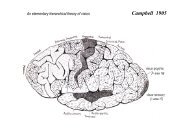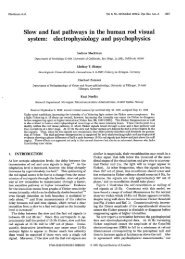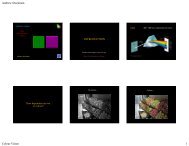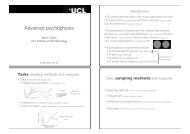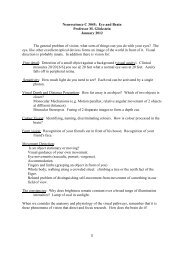Long-wavelength adaptation reveals slow ... - Journal of Vision
Long-wavelength adaptation reveals slow ... - Journal of Vision
Long-wavelength adaptation reveals slow ... - Journal of Vision
You also want an ePaper? Increase the reach of your titles
YUMPU automatically turns print PDFs into web optimized ePapers that Google loves.
<strong>Journal</strong> <strong>of</strong> <strong>Vision</strong> (2005) 5, 702–716 Stockman & Plummer 709linearly combining them with L:M cone weights <strong>of</strong> 1:1 or2:1. These weights were chosen to indicate the variationfound in the population, which on average favors L butshows considerable individual variability (e.g., Cicerone& Nerger, 1989; De Vries, 1948a; Sharpe, Stockman,Jagla, & Jägle, in press; Stromeyer, Cole, & Kronauer,1987; Vos & Walraven, 1971; Walraven, 1974). SubjectAS is known to have a weight <strong>of</strong> about 1.7 L:M on awhite daylight background (Sharpe et al., in press). If<strong>adaptation</strong> is limited by Weber’s Law, the spectral sensitivityshould not cross the appropriate Weber limit foreach subject.At the lowest 658-nm background intensities, the spectralsensitivity ratios for both subjects for detecting 15and 22.5 Hz flicker are closer to M than those for detecting2.5 and 7.5 Hz flicker. As the 658-nm backgroundradiance is increased, the selective attenuation <strong>of</strong> theL-cones by the deep-red field causes the 520/650-nmratios, as expected, to move towards the Weber limit.Between 11.0 and 11.2 log 10 quanta s 1 deg 2 , however,the Weber’s Law predictions are exceeded and the 520/650-nm ratios approach M. Although surprising, thisBsuper-Weber[ behavior has been reported at frequenciesbetween 15 and 22.5 Hz several times before (De Vries,1948b; Eisner & MacLeod, 1981; Stockman, MacLeod, &Vivien, 1993; Stromeyer et al., 1987).The most remarkable changes in spectral sensitivityoccur above 11.3 log quanta s 1 deg 2 , where the 520/650-nm ratios for the detection <strong>of</strong> 15- and 22.5-Hz flickerfall precipitously, cross the Weber limit again, and approachL (Stockman, Montag, & MacLeod, 1991). Indeed,the ratio for DP reaches as low as 1 log unit, whereasthat for AS reaches about 1.35 log unit. These changesare opposite to the expected effects <strong>of</strong> chromatic <strong>adaptation</strong>,which predicts the spectral sensitivities to be closeto the Weber limits. The sensitivity ratios for 2.5 Hz,in contrast, remain close to M, whereas those for 7.5 Hzremain roughly between M and the Weber limit. Thisfrequency-dependent difference is important because itshows that the change is not just an overall suppression<strong>of</strong> the M-cone signal.The interpretation <strong>of</strong> the spectral sensitivity data interms <strong>of</strong> the model can be simplified by considering separatelythe effects <strong>of</strong> signal interactions on the resultantM- and L-cone signals. According to our model, the predominantsignals at the lower levels are sM, +sL, +fM, and+fL. Thus, at low frequencies the M-cone signals canceland the L-cone signals sum (so causing a spectral sensitivityshift towards L), but at higher frequencies, because<strong>of</strong> the delay <strong>of</strong> the <strong>slow</strong> signals, the M-cone signals constructivelyinterfere and the L-cone signals destructivelyinterfere (so causing a shift towards M). In contrast, thepredominant signals at higher levels are +sM, sL, +fM,and +fL. Thus, at low frequencies the M-cone signals sumand the L-cone signals cancel (so causing a shift towardsM), whereas at higher frequencies, again because thedelay <strong>of</strong> the <strong>slow</strong> signals, the M-cone signals will destructivelyinterfere and the L-cone signals constructivelyinterfere (so causing a shift towards L). Our dataare broadly consistent with these predicted shifts.At the critical radiance at which the sM+sL and+sM sL signals are assumed to cancel, the spectral sensitivitywill be that <strong>of</strong> the fast signals (+fM and +fL). Giventhat the two fast signals are additive with little phasedelay between them, the spectral sensitivity at the criticalradiance should be close to the Weber’s Law prediction,which is roughly the case for both subjects at 7.5, 15, and22.5 Hz. At 2.5 Hz, the spectral sensitivity is probably influencedby that <strong>of</strong> the Btrue[ chromatic channel (which generatesa color percept but does not cancel luminance flicker).Photopigment bleaching becomes significant at the highestfield radiances. It has the effect <strong>of</strong> reducing the conephotopigment optical density and narrowing the cone spectralsensitivity functions (for a discussion, see Stockman&Sharpe,1999). Consequently, it increases the 520/650-nmsensitivity ratio and reduces the paradoxical shift towardsL that we find at the highest levels.Flicker detectionFigure 5 shows the flicker detection threshold versus radiance(FTVR) curves for AS (top panel) and DP (bottompanel) from which the sensitivity ratios shown in Figure 4are calculated. The dashed diagonal lines, which correspondto Weber’s Law (i.e., a slope <strong>of</strong> one in double-logarithmiccoordinates), are shown for comparison.Several features <strong>of</strong> the FTVR functions are noteworthy.The most obvious feature is that the slopes <strong>of</strong> the 15- and22.5-Hz curves for detecting 520-nm flicker exceedWeber’s Law in the unshaded area <strong>of</strong> the figure between11.21 and 12.13 log 10 quanta s 1 deg 2 (having a meanslope <strong>of</strong> c. 1.1 for AS and 1.3 for DP). A second feature isthat the 520-nm FTVR curves fall short <strong>of</strong> Weber’s Lawin the pink area below 11.21 log 10 quanta s 1 deg 2 . Thisshortfall reflects mainly the fact that Weber’s Law has notyet been reached by the M-cones on the deep-red field,but it may also be due in part to constructive interference.A third feature is that the 650-nm FTVR curves for bothAS and DP roughly follow Weber’s Law at all intensities,except perhaps for some slight steepening just before11.21 log 10 quanta s 1 deg 2 .According to our model, these FTVR curves, like thespectral sensitivity data, should reflect the effects <strong>of</strong> destructiveand constructive interference between the <strong>slow</strong>and fast signal components. Those regions within whichdestructive interference occurs might be expected to haverelatively steep slopes (because the signals cancel andreduce sensitivity), whereas those in which constructiveinterference occurs might be expected to have relativelyshallow slopes (because the signals add and increasesensitivity).




